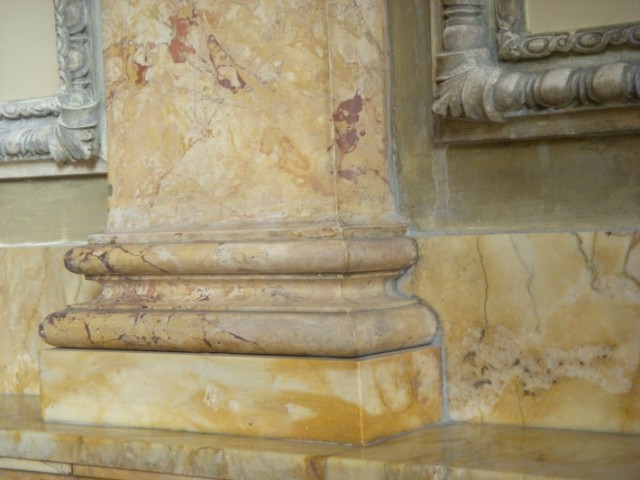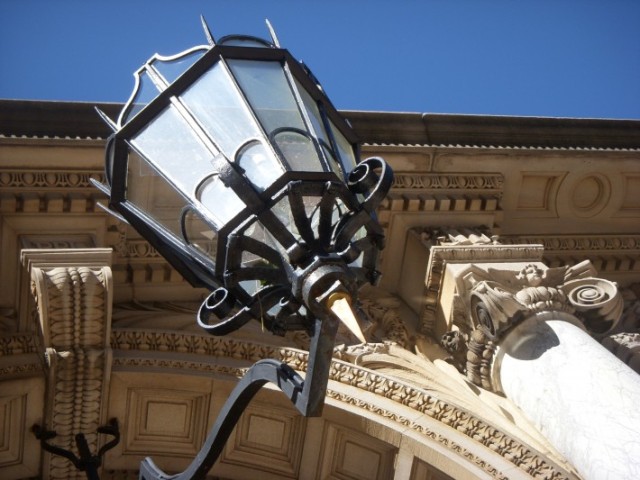
A gentle depiction of the 1954 addition, by Howe, Prout & Ekman, to the Providence Public Library. It could be worse, nevertheless it blocks the excellent original. Worse still is what you get behind this “basement” entrance.
Dale Thompson has retired after 25 years as executive director of the Providence Public Library. I make no comment on her accomplishments, except to note that over that span she – and the library’s board – oversaw the renovation of the library and the return of its entrance to its original main facade on Washington Street in the 1990s, and then, horror of horrors, a return, in 2005, back to the dull entrance on Empire Street used since the opening of a modernist addition, in 1954, that failed to live up to the 1900 original, designed by Stone, Carpenter & Willson.
 The addition not only blocked views of the original but offered a decidedly desultory ambiance for library users. Essentially, the basement suddenly became the main lobby.
The addition not only blocked views of the original but offered a decidedly desultory ambiance for library users. Essentially, the basement suddenly became the main lobby.
This switch was designed to support the library’s phony claim of having created a new branch in the central branch, a bid for more city money (the library is private). The gambit failed, straining relations between the library, the city and the city-funded branches, which have since split off to form their own library system for the neighborhoods, taking the city money with them.
To add insult to injury, this past year, in a program ridiculously called “Opening Our Doors,” the library reopened its original entry on Washington – but only to the 1 percent, which was invited to lease the space for parties. I have no beef with renting out the library, but I do have a beef against not taking the opportunity to reopen the original entrance to the public as well.
The photos below attest to how the public has been ripped off by the library’s heroically flawed management in recent decades. The original facade is scarcely seen by the public, and the best interior spaces are off limits to the public. May the new director, Jack Martin, formerly of the New York Public Library, prove to be an improvement. Welcome to Providence.






 The final photo is, of course, what is inflicted upon library users today. May change be on the agenda.
The final photo is, of course, what is inflicted upon library users today. May change be on the agenda.






I’m part of a grad arch studio here at Roger Williams and our project is to “reinvent” PPL and make it a library of the future. I think its funny, that all of my studio mates want to tear down both the original building and the Empire building. Their argument is that they are both old and no longer represent what a library is or should be. But, I know their real reason for wanting to tear both down…it would make their lives a lot easier to design their library projects. Oh, and they hate classicism. Full disclosure, I love both classical and modern architecture, but couldn’t ever see myself wanting to tear down the original building just because of its old.
I agree something needs to be done about the Empire building and the fact that is a complete disaster with no real relationship to the original building (other than being attached to it), and that there is no sense of orientation inside, as well as the lack of a relationship to the outside world.
LikeLike
Kevin, I would be very interested in why your fellow students seem to hate classicism. It is sustainable where modern architecture is not. It contains the DNA of humanity whereas modernism is sterile. Classicism pleases the average person much more than modern architecture does – every study and poll says so. I would value having an open-minded discussion with you, and for that matter the rest of your class, about why young people dislike classicism. (I suspect the idea of my coming to speak to your class would give your professor a heart attack.) Please write me at my email, dbrussat@gmail.com. I can also steer you to more that I’ve written about the library, if you would like. You are right about the Empire Building. Also, why do your fellow students think that neither the beautiful main branch nor the tedious addition represent what a library is or should be. What do they think it should be?
LikeLike
Hi David, I sent you a reply via email several days ago. I’m not sure if you got it, but it was from kkeller112@g.rwu.edu. I’d love to hear back from you and read some more of your articles on PPL.
LikeLike
Dave, I came to Rhode Island in the 1960s, and as a devotee of libraries, I visited the PPL. What a shock when I saw this brutalist/Stalinist, call it what you will facade on Empire Street. I could never figure out why the lovely, graceful entrance was closed to the public, and we entered into a concrete prison. Of course, lack of parking made it almost impossible for me to take our daughters there when they were young and addicted to libraries, too. Then we joined the Athenaeum, and I never went back to the PPL. A shame.
LikeLike
Right on the money, David.
LikeLike
Though I frequently quibble, politely beg to disagree and occasionally foam at the mouth at your clinging to classicism, for once I agree wholeheartedly with you. And I bet everyone who works in the library feels the same. Inside and outside, the library is disfunctional as a working building. And until converted to catering, itsgrand spaces were largely unused (except for the world-class boat models).
Why is it that every architect called on to renovate or add to an older building moves the main entrance to some illogically inaccessible spot and reduces it from a classic grandeur to a cheesy back door?
Every addition to the RISD Museum seems to move the logical front door further from the action — OK, this time the whole place was basically spun 180 degrees and down a couple floors — with the curious convenience of a one-way escalator.
The MFA re-oriented itself so dramatically away from their parking that they had to start up valet parking service. When we tried to go out the old garage-side entrance, we were told it was now for groups, NOT individuals. Through the glass doors we could see the garage beckoning to us. But no, we had to wend our way back to the front of the building, exit there and retrace our steps outside the building… passing the “group entrance/exit” en route. Since the MFA reverted to a grand entrance, at least we get a dose of classicism with our exercise.
LikeLike
Often the original building plan (usually by a classical architect, sorry Lew) makes enough sense that any change reduces the quality of the experience, aesthetically certainly but also programmatically. This phenomenon is ubiquitous, certainly predating modernism, but since then the damage done is almost always more hurtful than was the case when human nature reared its head in the centuries before modernism.
LikeLike